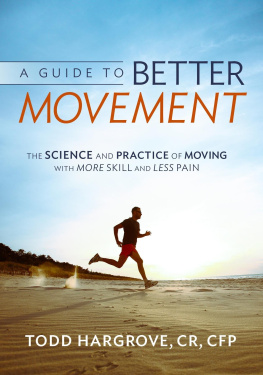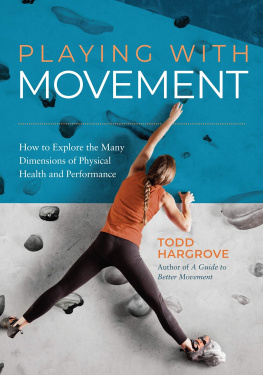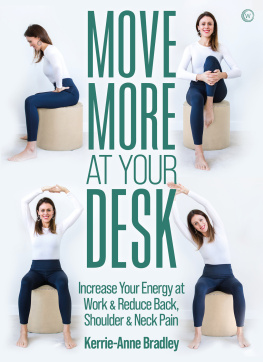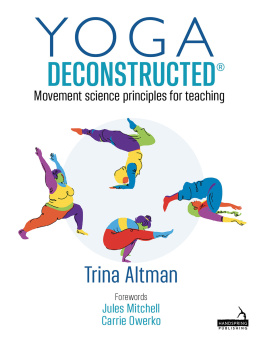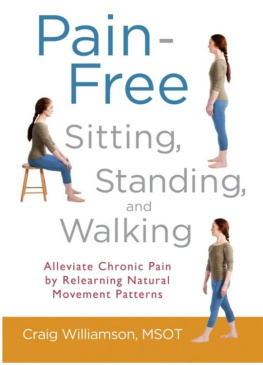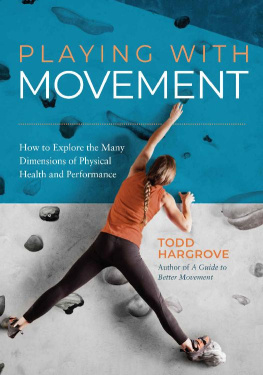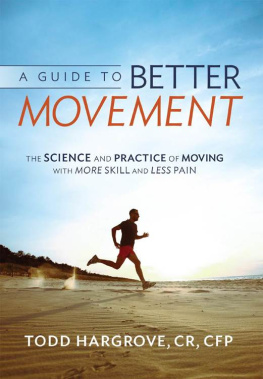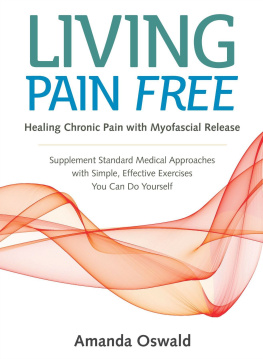Thanks to my teachers, colleagues, and clients for providing information, good ideas, criticism, and encouragement. In particular:
Paul Ingraham, Tony Ingram, Jason Silvernail, Diane Jacobs, Barrett Dorko, Greg Lehman, Michael Reoch, Alice Sanvito, Carol Lynn Chevrier, Will Stewart, Matthew Danziger, Chris Johnson, Michael Li, Nick Tuminello, Bret Contreras, Eric Cressey, Charlie Weingroff, Patrick Ward, Joel Jamieson, Phillip Snell, Gray Cook, Mike Boyle, Shirley Sahrmann, Craig Liebenson, Pavel Kolar, Stu McGill, Paul Hodges, Lorimer Moseley, David Butler, Tom Myers, Eric Cobb, Moshe Feldenkrais, Jeff Haller, Richard Corbeil, Frank Wildman, Dwight Pargee, Mabel Todd, Geoffrey Bove, Chris Highcock, Rafe Kelly, Seth Will, Stephan Guyenet, Brad Jones, Steven Pinker, Richard Dawkins, Nikolai Bernstein, Mel Siff. And many others!
And thanks to my family and friends for their love and support, especially Jemila, Juniper and Abezash.
PREFACE
I GREW UP PLAYING SPORTS. Organized sports, disorganized sports, team sports and individual sports. I played baseball and basketball through middle school, soccer through high school, and tennis through college. Even though upstate New York is not exactly a hotbed for college tennis, I was proud to play at the top spot for a few years.
I was always very interested in what made the good players good. Was it size, speed, strength, skill, conditioning? Was it practice or innate skill?
I became far more interested in these subjects when I started competing at pool in college. Im not sure why. Perhaps its because in pool, there are no obvious physical barriers to playing just as well as the pros. You dont need to be big, strong, or fast. You just need to hit the ball in the right place at the right speed.
Whatever the case, I became a little obsessed about playing professional-level pool. I bought every book I could find, and I watched videotapes of the pros for hours to analyze their technique. My friends thought this was pretty weird. Hard to blame them!
During this process, I discovered I have an unusual interest in watching movement, analyzing it, and figuring out how to emulate it. As a result, I became a pretty good pool player. (But not a pro!)
I soon learned I could become similarly interested in other physical activities. In my twenties I took up squash, and eventually won the A flight of the Seattle Open three times.
During the same time I was learning about movement, I was also, unfortunately, learning about chronic pain. In my twenties I spent a lot of time working at a computer as a law student and attorney, and this probably contributed to chronic pain in my neck, shoulders, and low back. My knees and feet hurt too. I felt like I was getting old in the prime of my life.
When I was in pain, I couldnt focus on my work. Or play sports competitively. Or enjoy sitting at a movie, or going on a long car ride. My sleep suffered and I just never felt truly comfortable or at home in my body.
I began reading large volumes of mostly conflicting information about what causes pain and how to treat it. I went to doctors, physical therapists, classes in yoga and Pilates. I read extensively about corrective exercise, functional training, posture, stretching, medical and alternative approaches to pain treatment. I soon realized that I found chronic pain to be a fascinating topic, even aside from its practical application to my life. And that I could become just as absorbed in the study of pain as I was in the study of performance. I also noticed many interesting connections between these seemingly different topics.
As a result, I made very steady progress over a few years until I eliminated my chronic pain. That was more than twelve years ago. Im now forty-six, continue to compete at sports, and feel terrific in my body. I get hurt from time to time, but I know how to get better. All in all, I feel better now than I did in my twenties, which makes me very optimistic about the potential for change we all have. I know its not all about getting old.
In 2005, I decided to quit being an attorney and find a career that was more aligned with my interests. I became a Rolfer and Feldenkrais practitioner and have been working in Seattle with clients since then.
In 2008, I started writing a blog to help family, friends, and clients better understand what I learned about pain and movement through my practice and research. Part of my intention was to correct common misconceptions that I see in people who have pain.
If someone in pain goes to a physical therapist, family doctor, surgeon, chiropractor, acupuncturist, personal trainer, or massage therapist, he or she might receive seven different explanations for their pain, and seven completely different treatments. And there is a very good chance many of these explanations or treatments will not be supported by any good science at all. Or even worse, in direct conflict with science! I saw people getting confused, distressed, and wasting time and resources.
There is a common theme in this confusion. Many therapists overemphasize the extent to which some alleged defect in the body is responsible for pain. For example, pain might be blamed on bad posture, imbalanced chi, a misaligned spine, a weak core, short hip flexors, muscle knots, or a bulging disc. At the same time, the role of the nervous system and the brain is neglected or misunderstood.
This is ironic because it is quite often the nervous system, and not some assumed pathology in the body, that actually changes for the better during a successful treatment. In fact, it is very likely that when someone feels better after a chiropractic adjustment, a yoga session, foam rolling, acupuncture, massage, or corrective exercise very similar mechanisms are at play. And this is true even though the practitioners might imagine they are aiming at completely different targets. Recent advances in pain science and neuroscience provide significant insight into these mechanisms and how they can be most effectively accessed.

